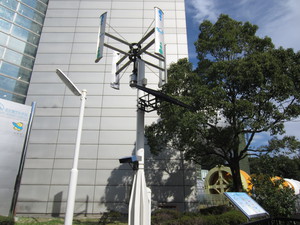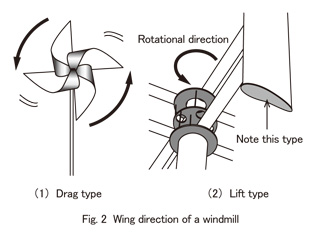Nagoya City Science Museum
TOP > Exhibition Guide > Floor Map> Wind Power Generator
Wind Power Generator



Purpose of Exhibition
This exhibit features the a device created by connecting a wind power generator and solar batteries together. It can generate and accumulate electric power in batteries and convey electricity for lights used at night time.
Additional Knowledge
Since wind power generation only uses wind power to produce energy, without doesn't consuming consume resources like petroleum and, coal and has no carbon dioxide emission, it is drawing attentions as a measure to prevent the depletion of energy resources and global warming.
[Advantages of Wind Power Generation]
As described above, if we use the non-depletinge natural energy called such as renewable energy, there is no worry about the depletion of energy resources. Also, it emits no carbon dioxide while generating electric power, so it doeswill not deteriorates contribute to the global warming problem. Besides that, this energy can be made even onin isolated islands o where it is difficult to transmit electric energy,. andAnd a large-scale wind power generation facility can be constructed in an area where wind blows stably. Recently large-scale wind farms have been built on the sea all over the world.
[Disadvantages of Wind Power Generation]
Naturally, wWind power generation depends heavily on wind, so it is hard to ensure a stable supply of electricity in areas where wind does not blow. As the number of wind power generation facilities increases, some problems have sprung up, too, such as, noises and bird strikes, in which birds die from collision with wind turbines.
[Types of Wind Power Generation]
Types of wind power generation can be divided depending on the form of a turbine.
・Classified by the direction of the axis of the wind turbine. There are wind turbines, whose rotation axes are vertical and horizontal. The ones that needs to change direction of wind turbines have a horizontal axis. AThe typical example of thisat is the onea turbine with three propellers when it comes tofor wind power generation. Since the oneAs for the turbine with the vertical axis, there is no need to worry about the direction of wind, therefore the structure is simple. The wind power generator in the exhibit of the City Science Museum has a vertical axis.
・Classified by the form of the blade in the wind turbineA wind turbine rotates when it catches wind. There are two ways to change blowing wind into rotational force. One is by receiving wind, and iswhich rotates the turbine by force. This, which is called a drag type. You can see this type in Dutch classic windmills. Also tThis type can also be seen in toy windmills. The other is referred to as the lift type, and the blade plays the same role as a plane wing. The cross section of the blade is the same as a plane wing, and. And the turbine is spun based on the same principle that plane wings get lifted as they receiveing wind. Wind power generation with propellers and the exhibit in the City Science Museum are lift- type turbines.
[Wind Power Generation in the Nagoya City Science Museum]
There is a small wind power generator in the south garden of the Life Science Building. With 4 blades, each one is 3m in diameter and 2m in height, and in the case of a 12m per second wind velocity, 1,360 watts of electric power can be obtained. Also, theyThey are also equipped with solar batteries. Additionally, in the upper north east side of the City Science Museum, two wind power generators are situated, and the size of each unit is 2.4 m in diameter., Tthose generators have 3 blades, and one blade is 5.16m in height. In case of a 12m per second wind velocity, it can generate 6,000 watts of electric power for the 2 units all together.
CooperationNagoya Johoku Lions ClubArticle by Yoshitaka Yamada, curator
